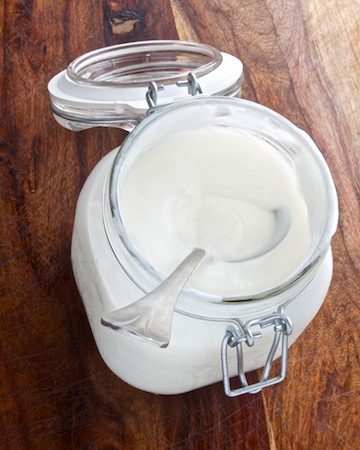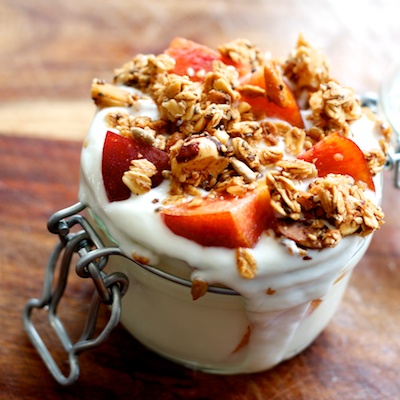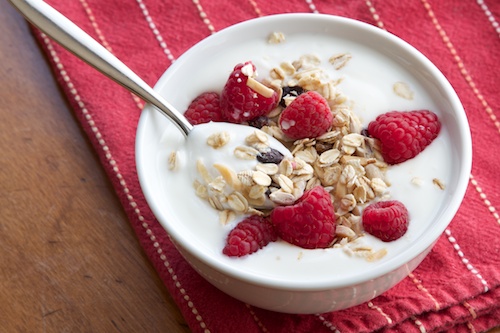There’s always a lot of fermentation going on around here. Yeast is doing plenty of that work, but bacteria also get in on the action. Sourdough cultures contain — along with wild yeast — one or more strains of Lactobacillus, which produce the acids responsible for the “sour.” But lactobacilli like to ferment other things in addition to flour; they help turn cabbage into sauerkraut, cacao into chocolate, and apples into cider.
Then of course there’s milk, for which the bacteria were named in the first place. Lactobacilli love lactose (the sugar in milk), and the resulting yogurt loves us! Medical research suggests that regular consumption of yogurt, like other fermented foods, has beneficial effects on cholesterol, immune function, and digestive tract health (some references for these claims are listed below). Yogurt is also rich source of calcium and protein, and can often be enjoyed even by people who are lactose-intolerant. Or you could forget all that and eat it just because it’s tangy and creamy and delicious.
In any case, the good news is that it’s simple to make your own. Heat the milk, add a little “starter” (store-bought yogurt or some of your own from the last batch), keep it warm for a few hours, and you’re done. No really, it’s that simple.

I love my Brod and Taylor proofer for making yogurt. It maintains a constant and easily adjustable temperature, and you don’t need special containers like you do for a specialized yogurt maker; any glass or ceramic jars will work, as long as they fit inside the roomy box. The yogurt-making method on Brod and Taylor’s website is easy, relatively fast, and yields a smooth, mild-flavored yogurt that has earned wonderful reviews from everyone I’ve fed it to. In fact, while I can’t tolerate the very sour flavor of plain store-bought yogurt, I can eat this without any accompaniment at all — although a sprinkling of muesli and a few raspberries certainly don’t hurt!
I’ve been making yogurt every week or two for the past few months. Here are a few pointers I’ve picked up along the way:
- Whole milk (3.5% – 4% fat) yields the creamiest yogurt. If you use unhomogenized (cream-top) whole milk, you will get cream-top yogurt. In that case, I suggest using single-serving jars for culturing, so the cream can be mixed in right before you eat it. I prefer homogenized milk myself.
- A flour sack towel set inside a mesh strainer is ideal for straining yogurt for a few hours to make it Greek-style. Strain it even longer and it becomes as thick as cream cheese. Save the whey you strain off and throw it into smoothies.
- An instant-read thermometer is a nice thing to have.
- If you are culturing more than one jar, check each one individually for “doneness” (when the yogurt is set so that the top does not move when you tilt the jar). Usually it’s all done at the same time, but I have had batches where some jars (even of the same size) took longer than others.

Long-term consumption of fermented dairy products over 6 months increases HDL cholesterol. Eur J Clin Nutr. 2002; 56(9):843-9.
The effects of probiotic and conventional yoghurt on lipid profile in women. Br J Nutr. 2010; 103(12):1778-83.
Daily intake of probiotic as well as conventional yogurt has a stimulating effect on cellular immunity in young healthy women. Ann Nutr Metab. 2006; 50(3):282-9.
Role of yoghurt in the prevention of colon cancer. Eur J Clin Nutr. 2002; 56 Suppl 3:S65-8.
A randomized trial of yogurt for prevention of antibiotic-associated diarrhea. Dig Dis Sci. 2003; 48(10):2077-82.

Susan,
I’m a vegan and don’t have access to vegan yogurt.
Do you think my sourdough culture will work here (Only for the first time). Is it the same strain?
THANK YOU, THANK YOU, THANK YOU. I am the grateful winner of your contest a few months ago! This is the most fun, AND I am making yogurt at least 2 times a week (or more). So Easy, so good,
Right now we’re super HOT in Kansas so not baking bread but will put to good use later in the fall and winter.
The proofer has it’s own little table so it’s ready all the time…BUT I saved the box it came in and found it will store when needed between the space of my Washer and Dryer. What a great idea, FOLDING!
What great photos – especially the one with the fruit and muesli. We love our homemade yoghurt too. We use our oven turned to around 100F (not easy to regulate – I’ll take a closer look at the Brod & Taylor proofer – I wonder if it could be used for drying tomatoes….)
Like you, we’re not wild about sour yoghurt so we always have to use commercial yoghurt as our starter. We’ve tried using our beautiful mild tasting yoghurt as the starter and end up with insanely sour yoghurt. (I don’t know WHAT it is about our house! Both times that I captured yeast, I made the sourest bread, no matter how much I experimented with temperatures, feeding times, feeding quantities, etc. etc.)
I never made yogurt, yours look perfect.
Susan, your yogurt looks thick, luscious and completely wonderful! Thanks so much for the mention.
I have never thought about making yoghurt from scratch before. I might have to give it a go. Thanks.
Gilad, there are several strains of Lactobacillus that can be present in both sourdough and yogurt. It’s an interesting question about whether you could use sourdough starter to get your yogurt going. And would you be using soy milk? I haven’t tried making vegan yogurt. Why don’t you try it and report back?
OK Susan – I’ll try and report.
My plan is to make a 200% hydration sourdough and use some of it as a starter.
good idea and very interesting recipe! thank you 🙂
I splurged and got the Brod and Taylor proofer. I love it! It helps provide perfect temperatures when making bread and is a wonderful tool for making yogurt as well.
My sister gave me my first yogurt maker back in the mid-70’s. I was hooked! There is nothing better than homemade.
Yogurt can be made inside of an electric oven, heat off, light bulb, on. I watched my friend make hers this way for years. Seema simply prepped her culture (just a tablespoon or two), in a quart of milk on her stovetop until it was lukewarm, then poured it into babyfood jars and placed it within the oven to ferment overnight. I must add….the lightbulb was the regular old kind, appliance bulb, not a new fan-dangled energy saver.
I cheat. I use a yogurt maker…when I remember to take it from the bottom cabinet and get myself in gear…
😉
I usually make my yoghurt in a pre-heated cooler (ha! that sounds strange) or the oven but the Brod and Taylor site had some good tips on making it thicker and less sour, thank you!
Hi All … I use a nice tip I found online … I put a heating pad (medium setting) inside a cooler covered with a towel. On the towel I place my bowl of yogurt, covered. Then I cover the towel over the yogurt. Close the lid on the cooler. It won’t close all the way because of the heating pad cord. Do this in an evening and then in the morning you have perfect yogurt. :o)
Making yogurt always seemed so complicated, thanks for breaking it down in a way that even I can understand!! This is something that I will try, thanks for the easy to follow directions!!
In addition to the tips for making milder and thicker homemade yogurt, Brod & Taylor also has an article on how to maintain a yogurt culture on their blog, and a recipe for soy milk yogurt for those looking for a vegan option.
I use a quart jar or a recycled pasta sauce Jar. Put in 2% or whole milk. Heat in the microwave for 2 1/2 minutes, add buttermilk or cottage cheese as a starter, cover with a coffee filter and it is ready (set) in two days or so. Makes great yogurt. The coffee filter keeps unwanted cultures out. For variation you can pour warm milk over unwashed grapes. (Grapes have a natural yeast which protects them and keeps the grapes fresh for weeks in the refrigerator.)
I’ve been making yogurt from scratch for years. However this time, (i kinda had a brain fart and messed it up a bit) it smells like yeast. Actually, it smells like a delicious yeasty roll, but I digress.
Anyhow, if it’s safe to eat I don’t want to waste it all, but if not, I’ll find other uses. Anyone know if the yeasty yogurt is safe to consume?